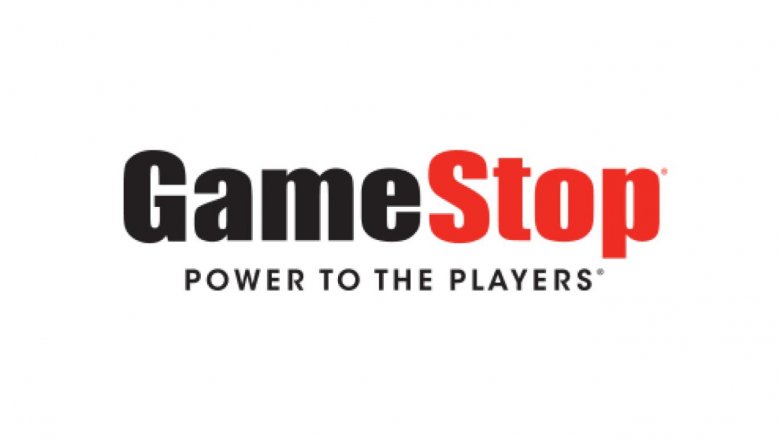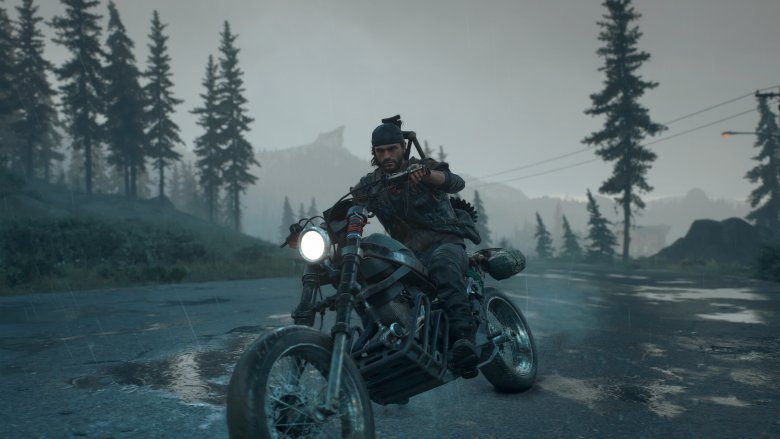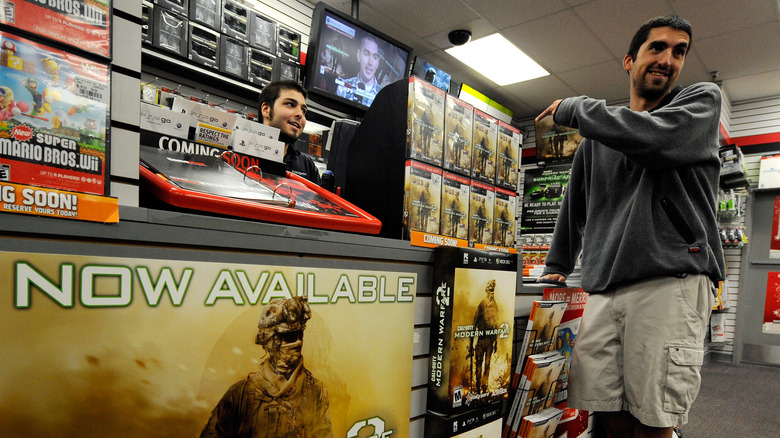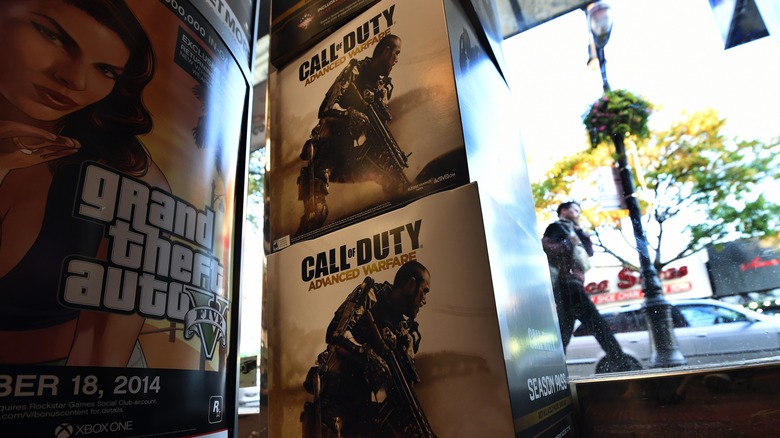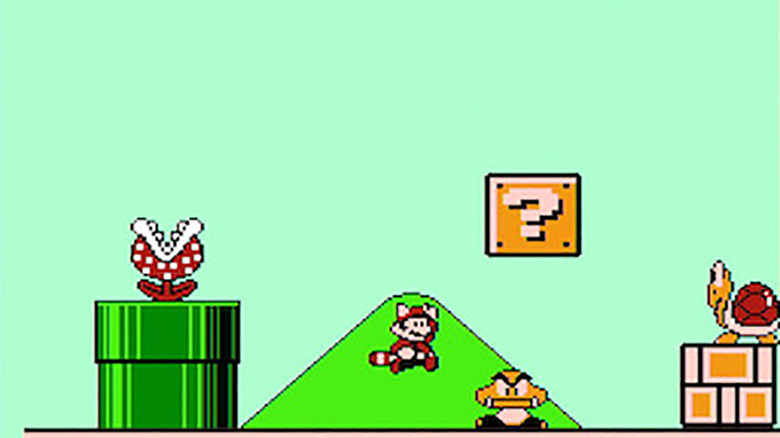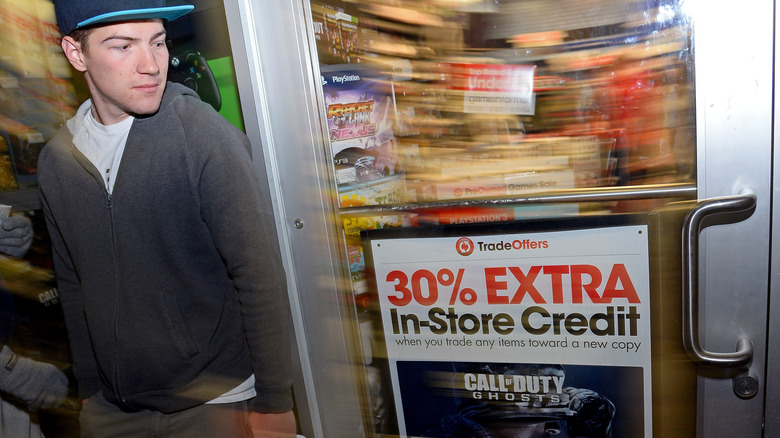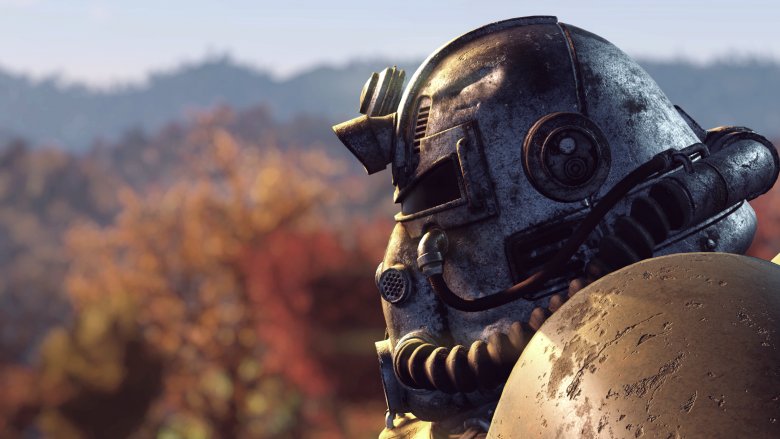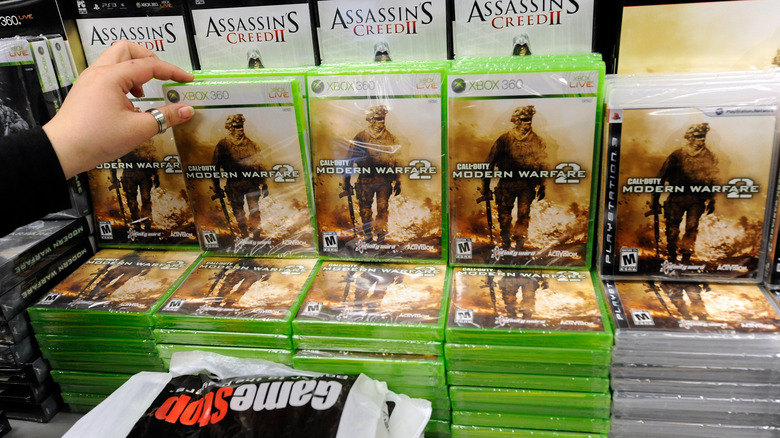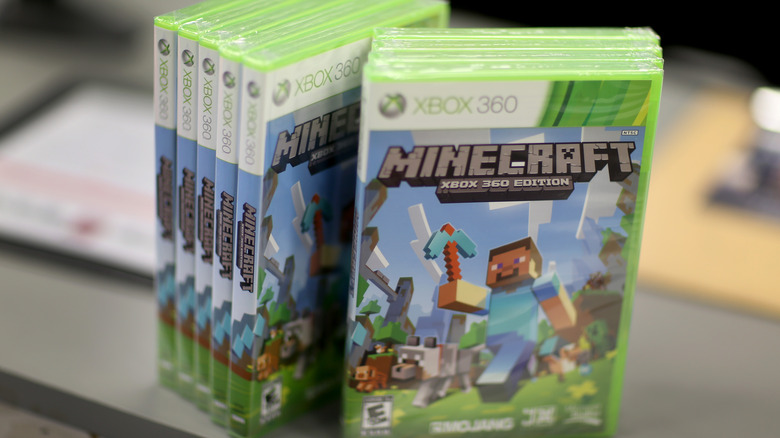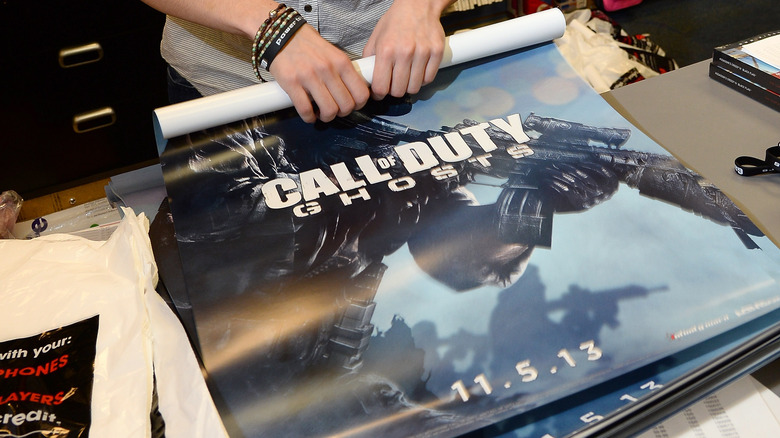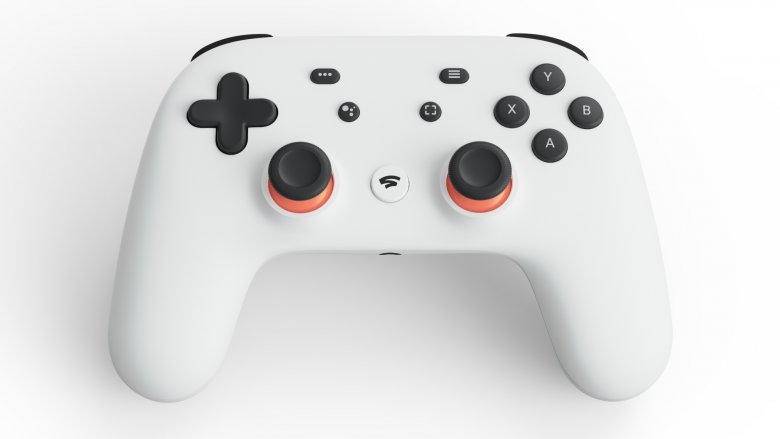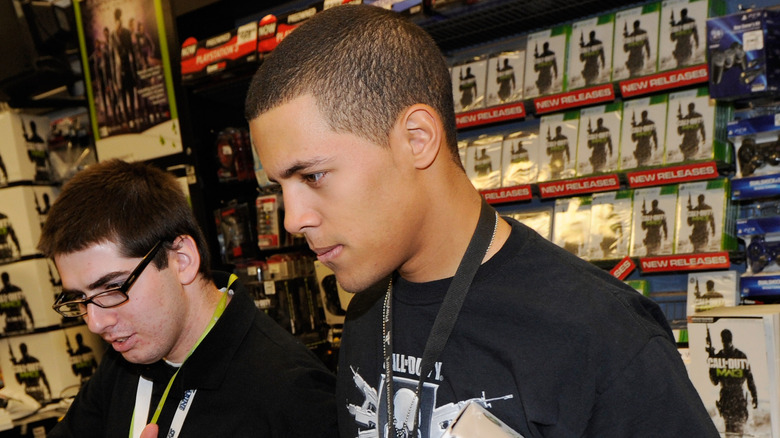Signs Gamestop Is Getting Desperate To Stay Alive
The eighth generation of consoles brought many things to the forefront of the mainstream gaming community. 4K gaming became more possible than ever before, and seemingly one out of five games have a photo mode now. Perhaps the most groundbreaking shift was the drastic change in the digital storefront landscape. Consumers are buying games digitally now more than ever before, and it's hurting one entity the most: GameStop.
Year after year, it becomes more apparent that GameStop has started to lose its relevance to the industry at large. At every step of the way, the market for a third-party physical game reseller keeps shrinking. Within recent memory, GameStop resorted to some pretty desperate tactics to reclaim the firm grasp it once had on the market. Unfortunately for the company, it seems like nothing can stop the digital tide that's taking over.
The times are changing, and GameStop seems unable to change with it. No matter how many times a sales associate pushes PowerUp Pro memberships or Game Informer subscriptions, the company at large is starting to lose money and clout. So join us as we recount the (many) signs of GameStop's desperate struggle to stay alive.
48 hours to play for (almost) free
GameStop's business model is pretty simple. The store sells new games at retail prices, and it buys back any items customers trade in for a fraction of the cost. Then it turns the game right back around, selling these pre-owned titles for a hefty premium that still sits below retail prices. Used sales save you some cash, all while GameStop itself makes all the money.
Well, that all changed with the release of the PlayStation 4 exclusive Days Gone. GameStop rolled out a new program called "Guaranteed to Love It," which essentially lets you play games nearly for free. If you buy a game within the first few days of its release, you can return it within 48 hours of purchase for a nearly full refund. The only thing you lose out on is sales tax.
The program only applies to Days Gone as of this writing, with the expectation that it could apply to future releases. Sure, the window of time is a little narrow, especially for large, quest-laden open-world games. But that doesn't change the fact that GameStop now offers an option that costs them money on new, major releases.
Perhaps the retailer intended to move more copies with the enticing proposal. Ultimately, it looks like a desperate attempt to get more people to buy Days Gone from their storefront over any other brick-and-mortar shop.
The subscription service that never was
In October 2017, GameStop announced a new subscription service called PowerPass. For $60, customers could keep a pre-owned game at home over a six-month period. Subscribers could only have one game out at a time, but they could rotate different titles out, like a library. At the end of the time period, they could keep whatever game they wanted. It all sounds too good to be true, and in some ways, it was. Just days before it went live, GameStop suddenly shut it all down.
In a way, the program sounds like a quick and dirty solution to move a surplus of their pre-owned game stock. These products couldn't sell, but they could be used for a library-like subscription service. It comes off like a last-ditch effort to do something with all the games they had lying around.
But why did GameStop make the library of games stop? According to a spokesman's statement given to Kotaku, the company identified a "few program limitations." We don't have any details beyond that. Nonetheless, it's worrisome to think that no one working at GameStop caught these "limitations" until a week before the program would go live and (presumably) fallen apart.
Customers who pre-ordered a PowerPass subscription were completely refunded, and as an apology, they could take home one pre-owned game for free. At least GameStop got rid of some of its surplus in the end.
Too little too late
During a console's life cycle, major games tend to get bundled with it to push sales. All sorts of retailers do this, GameStop included. However, up until 2015, the retailer offered digital games along with consoles. As you'd expect, these games couldn't be returned to GameStop in any way, by virtue of their digital nature. So, by extension, the company gets less pre-owned games to work with while inadvertently supporting the digital game market.
In the latter half of 2015, the retailer stopped bundling digital games with consoles, replacing them with physical ones. Of course, then GameStop CEO Paul Raines defended the move, claiming it was made with the consumer's best interests at heart. Your average customer prefers "those physical bundles, because they know that the disc has value in the trade-in program at GameStop," he said.
Supporting its own trade-in program makes sense. At the end of the day, a business exists to make money. However, this decision also comes off as a small, petty attempt at curbing the rise of digital game sales. Here we are, four years later, and the impact of this business decision can't be felt in the slightest.
Late to the retro party
Nostalgia is a powerful motivator. No matter how many cutting-edge leaps we make in retina-searing graphics, gamers will always have a soft spot for those 8- and 16-bit sprites. Local game shops have known about this for years. Chances are, if you have an iota of interest in retro gaming, you've walked into a brick-and-mortar game store that wasn't GameStop. In 2015, GameStop decided that it wanted a piece of that nostalgia pie.
The retailer started taking retro consoles and games, going all the way back to the Nintendo Entertainment System. These traded-in items would be tested and repaired to ensure they work. Then they would be sold for a premium, with GameStop making all the profit.
The company has a history of repairing broken consoles, considering how much they profited off Xbox 360s that got hit by the Red Ring of Death. Expanding to retro games seems like a natural extension. However, local game stores have kept the retro market alive and strong for years now. Old-school gaming enthusiasts tend to stay loyal to their mom-and-pop shops. But GameStop's retro games initiative comes off as the company forcing itself into a market it never was a part of. The big corporation all of a sudden wants some of that niche retro gaming money — or, maybe more accurately, it needs that money.
It's the circle of life, and it hurts us all
In February 2017, Kotaku published a report about GameStop's Circle of Life program. Under it, employees had to meet a percentage quota of used game sales, pre-orders, PowerUp subscriptions, and game trade-ins. The more new games and consoles a store sold without any of the previously listed items, the harder it became to meet those quotas. Failure to meet these numbers counts as grounds for losing your job, leading many employees to lie to customers just to stay employed.
The shocking nature of the Circle of Life sparked a lot of outrage in the community. It made the corporate upper management of GameStop look awful, as if they were forcing their lowly employees to turn lead into gold. Threatening to fire people for not selling enough pre-owned games is a sleazy, desperate move that emphasizes the company's bottom line at the cost of good customer service and employee morale.
Before the month was over, GameStop publicly announced that it was changing the policy behind the Circle of Life. Now, instead of tracking individual sales associates, each store is held to a quota. Furthermore, new game sales count toward this quota, ending the discouragement of selling new games. Think about that for a minute: GameStop, a video game store, actively discouraged selling brand new games and consoles so it could sell its pre-owned stock, regardless of what a customer might want.
They're literally giving these away
If you were in the market for a used PlayStation 4 controller in early 2019, we hope you happened to be in Germany at the time. The GameStops in Germany were running a promotion where every purchase of a used DualShock 4 came with a free copy of Fallout 76. Sure, some would say that's a worse deal, considering the game's quality, which can be described as questionable at best. But consider the position GameStop had to be in to offer that promotion in the first place.
In all likelihood, these German GameStops had too many copies of Fallout 76 in stock. Maybe they bet more than they should've on how many copies they needed, and the bad reviews likely didn't do much to drive sales. They needed to move copies somehow, otherwise they would keep taking up space. So what was the retailer's solution? Throwing it in for free with a used controller. It's just a couple steps away from offering a complimentary Fallout 76 when you walk through the door.
What's the opposite of growth?
2016 was a rough year for GameStop. In March 2017, the company reported a 13.6% drop in global sales. Competitors like Amazon and Best Buy proved to be formidable foes, and the general rise of digital storefronts didn't help either. Because of the poor year, GameStop planned on closing at least 150 of its stores by the end of 2017.
Chief Financial Officer Rob Lloyd told USA Today that this move served as part of an ongoing, yearslong plan that's been around since 2011. Although 150 stores are closing, some might merge with other nearby locations. At the end of the day, it's about improving the experience for the customer, if Lloyd's to be believed.
Nonetheless, a successful business doesn't close 150 locations over a year. This level of downscaling feels reminiscent of the stories of other major brick-and-mortar stores, like J.C. Penney and Sears. Unfortunately for GameStop, things don't look much better in fiscal year 2018.
The lost profit of GameStop
When you look at 2018 holistically, it was a pretty good year for video games. Capcom kicked off the year with Monster Hunter: World, and PS4 owners got to add God of War and Marvel's Spider-Man to their libraries. Nintendo ended the year with Pokémon: Let's Go and Super Smash Bros. Ultimate, while Rockstar rocked the world with Red Dead Redemption 2. There was no shortage of great games to sell in 2018. So why did GameStop lose $673 million that year?
During that year, the company even sold Spring Mobile for $700 million so it could focus on gaming and collectibles. Even after that huge influx of cash, GameStop lost more than half a billion dollars during a year full of outstanding software. The biggest hit it took in 2018 was to its pre-owned sales, which were down by 13%.
In fact, pre-owned sales have declined year over year since 2014, despite the Circle of Life program. No matter what the retailer tries to do, it seems like it's on a downward financial spiral. If it can't improve pre-owned game sales — the metaphorical lifeblood of the company — then how much longer will its storefronts still be around?
A critical failure
After losing 150 stores in 2017 and $673 million in 2018, it's easy to feel sorry for GameStop. The company is $820 million in debt, and if it keeps losing money, that won't be an easy debt to square up. Unfortunately, things are looking even worse in 2019. The company had been looking for investors to buy the company. However, by the end of January 2019, GameStop had given up looking for buyers.
According to a statement, it had given up because of a "lack of available financing on terms that would be commercially acceptable to a prospective acquirer." In English, that likely means GameStop found people who were interested in investing, but lenders couldn't be convinced that the company was worth the money.
We can't say for sure if this will become a defining moment in GameStop's history, but it certainly doesn't look great. Successful companies rarely look to others to buy them out. More often than not, it's a sign that a company's finances have seen better days, which looks like the case for this video game retailer.
For the times they are a-changin'
In reality, we could be seeing GameStop in its twilight years. As the years go by, more and more games are being sold digitally. According to SuperData, a Nielsen company, 2018 saw huge leaps in digital video games and interactive media. The rise of cross-platform games, esports, and virtual reality all contribute to the thriving digital landscape. To put it in perspective, Eurogamer reported that nearly 80% of video game sales in the UK were digital in 2018.
Beyond the rise of digital storefronts, the landscape of how people play games is on the cusp of changing drastically. Microsoft has found success in its Xbox Game Pass, a subscription service that digitally delivers a library of games to your console. In the same way Netflix revolutionized how we watch movies and TV, Game Pass, as well as Sony's PlayStation Now, lead the charge toward a new way for people to play games. And this new way, you might have noticed, cuts brick-and-mortar stores completely out.
Tech giants Google and Apple are also jumping in on the trend. The Apple Arcade offers a similar deal as the Xbox Game Pass, but it's specifically limited to iOS, Mac, and Apple TV. Google, on the other hand, announced its newest platform, Google Stadia, which lets people play games on practically any device with an internet connection. All of these digital solutions are shaping the future of gaming, and it's a future that doesn't favor GameStop's business model.
Cut out of the equation
If you don't buy into digital gaming subscription services, then you may want to avoid Microsoft's newest console. The Xbox One S All-Digital Edition performs just like any other Xbox One S, except for one major factor: it lacks a disc drive, bringing the cost down to $249. Despite its unfortunately sad acronym, this new console doesn't bode well for GameStop, a store that primarily deals in physical games.
While the move may be a bit extreme on Microsoft's part, it shows a clear shift in the market. GameStop considers itself unphased in the face of a discless console. The company recently surveyed its PowerUp Rewards members and concluded that half of them would prefer to have a disc drive. The inherently biased survey serves as a talking point for the retailer, as if justifying its existence in an increasingly digital world.
Furthermore, Vice President of Merchandising Eric Bright said GameStop has a "full digital agreement with Microsoft that allows [them] to profitably sell digital games." Even if that's true, it's hard to imagine many gamers would leave their couch to buy a game digitally when they could accomplish the same goal at home. No matter how you cut it, a console that doesn't need physical games spells a bleak future for GameStop. If this move by Microsoft starts a trend, it could be the trend that leads to the retailer's demise.

